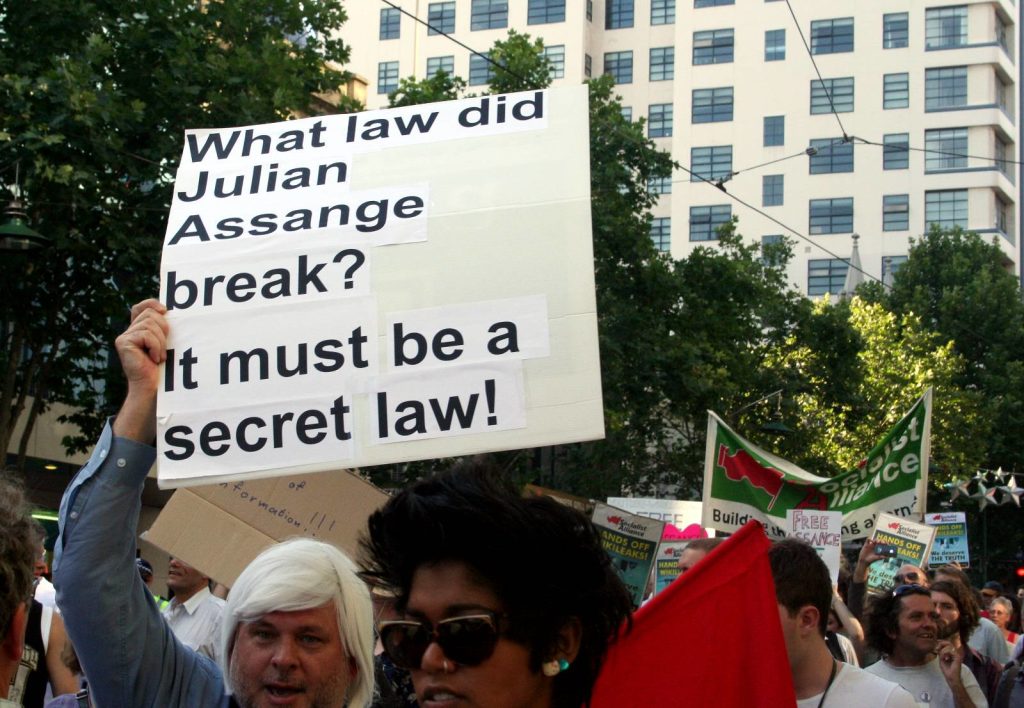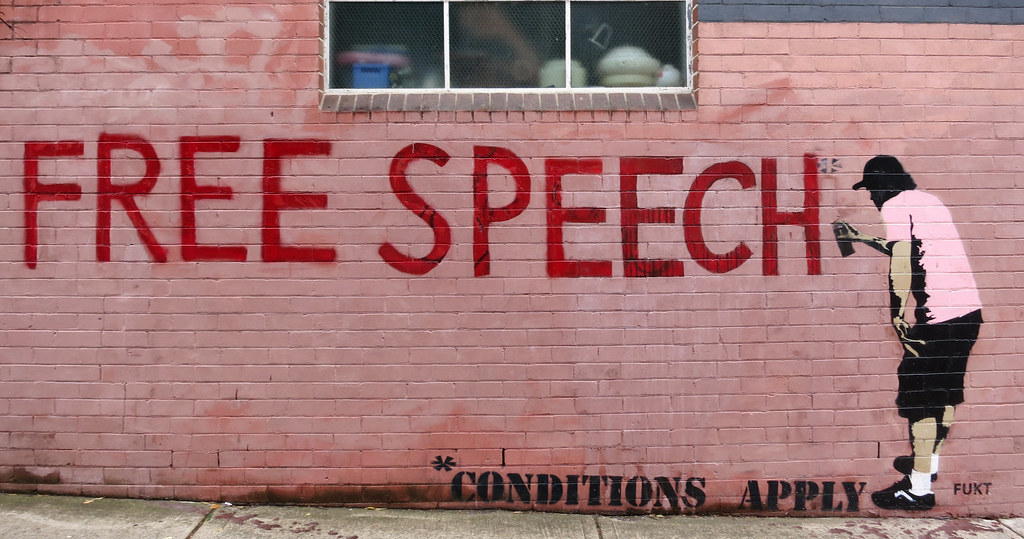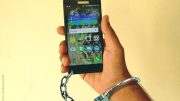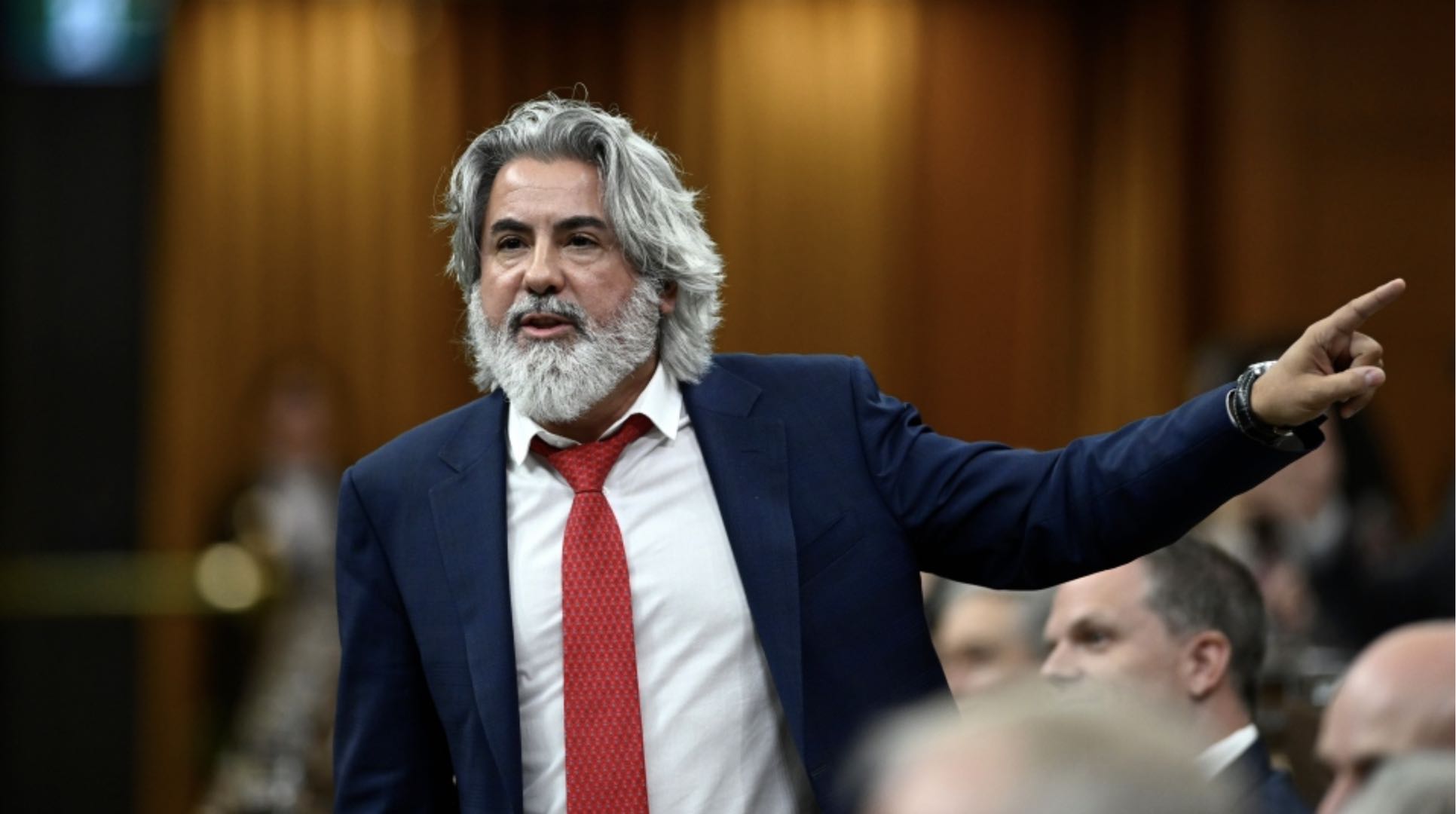By Fergus Flanagan

“What law did Assange break?” by John Englart is licensed under CC BY-SA 2.0
Introduction
The genesis of the internet and its global spread has brought with it unfamiliar challenges that are approached and resolved in unique ways across a number of cultures.
As a result of the “network effect” we have seen the meteoric ascension of internet companies having impacts on all social elements of our world. With what Dutton describes as the fifth estate of society (Dutton, 2009), the internet through its entirety has growing effects on all social aspects of life. Brought with this is an emerging paradigm of issues surrounding free speech as individuals and companies are more than ever before able to express themselves through this mode of communication as Rheingold asserts it brings “enormous leverage to ordinary citizens at relatively little cost”. Transnational companies of the likes Facebook, Google, Twitter and others of a similar vein cannot expect to apply a “one-size fits all” model of governance as there are poignant cultural differences that surround the users.
The intention of this text is to delve into the structure of control in Australia and how the transformation of the internet and events surrounding it eventuated in the current borders around its freedom of speech.

The Internet as a mirror of culture
In order to understand the limitations it is important to understand the cultural deviations and how they result in differences in the degree of speech that can be exercised on the internet. The internet being almost inextricably connected with politics, business and social life becomes an amalgam/representation of different values By looking at one of the largest users of the internet with 90% of the population engaging in social media, the United States for instance demonstrates the how ingrained the internet is within their society. As a result of the bill of rights, users are granted the freedom to express themselves and upon others is a manner that is not acceptable to Australia. Though there are many supporters of the uber-libertarian approach Nemes puts forth the notion that the first amendment is a “stumbling block” and it “silences minority opinion” (Nemes, 2010). A polar opposite to the US, China also shows how values and politics have an interplay as the sheltered country employs private companies to regulate expression and even enforce punishment, creating a sort of “self- regulation” Ruan et al (2020) .This could be evidenced through the Xi Jingping Winnie the Pooh situation.
While from an ethnocentric perspective this may be seen as dictatorial and on the lines of mind control, China and its surveillance reap the rewards in terms of lower crime rate and social upheaval.
Australia finds itself in the middle in terms of the regulation for expression on the internet. It does not have the dogmatic belief in the first amendment nor the overly controlling mechanisms in place but has been under criticism for the restrictions it has in place such as it’s arbitrary defamation laws.
Allman describes the constitution as implying freedom of speech but not directly giving it. Therefore there are many topics surrounding race, security, defamation, copyright and privacy that have legal consequences in its place as decided by the Australian Human Rights Commision (AHRS,n.d.). The contours of Australian regulation is blurry and the following cases demonstrate this.
Freedom of speech for companies
The migration of businesses towards the internet has brought about debatable scenarios such as the ability for companies to be subject to the laws of other countries.
With the commercialisation of the internet through Web 2.0 (DiNucci, 1999), the collection of data and the ability to sell products online became the new model of business. This disruptive innovation urged the hand of existing companies to become established in the internet world to compete.
An example where the internet and existing press media bodies clash is the creation of the Bargaining Code 2020. Disgruntled by Facebook and Google attaining monetary benefit from advertising Australian news articles, the News Corp group argued that these companies should have to pay an agreed upon rate. With this law passing, the code saw Google and Facebook acquiesce to the terms and payout but the resistance such as Facebook pulling all Australian news from the platform. Heylen points out the ludicrous tactics employed through the discursive language of ‘platform’ taking an innocent stance (Heylen, 2023).
To some the outcomes of the act showed that the companies profiting from others work could not teeter between being a publisher and not, but to others such as Youtuber FriendlyJordies, it served only as a spit in the face as it would only provide benefits to those who already comprised the ‘fourth estate’ (reference) rather than those individual journalists Google and Facebook helped elevate.
Interactions between companies and individuals have also come into the spotlight demonstrating new methods for defamation to take place such as Fairfield v Voller alongside Gutnick V DOW Jones. In particular Gutnick’s case from what Garnett states caused a very tumultuous period as it was the first precedent of a company being subjected to the jurisdiction of another country despite the post being made in America (Garnett, 2004). With DOW Jones posting content from America which would be considered defamatory here, Garnett explains Australia was criticised for breaking down the sanctions of different countries and causing hysteria.
In the case of Fairfax v Voller we see a similar interaction but instead Voller accuses Fairfax of defamation on account of allowing others comment on the post. Many consider it to be ridiculous to accuse Fairfax of having accountability for the voices of others but technically Fairfax provided an environment for such discourse to occur.
Matt and Meredith from Denton’s flesh out both perspectives in the following:
These cases, although entirely different, showcase the need for companies to be vigilant and navigate the unfamiliarity the internet still holds. There must be conversations and standards enforced to find an intersection where equilibrium is found between all stakeholders and the definition of a publisher and what they can do is actualised
Freedom of speech as individuals
Originally predicated upon what Barbrook calls the “Californian ideology” the internet was built on the foundations of a communitarian belief where people from different backgrounds could interact freely with one another. Though the libertarian ideals are lofty, as mentioned Australian citizens are not subject to the same aforementioned “Western Enlightenment Freedom”.
In regards to the megatrend of “amplified individuals” (SBI) Napoli explores whether or not with the surge of “fake news” and the purporting of hate speech shows a need for freedom of speech. Her argument questions the viability of the amendment when it can create falsehoods that could be harmful to any group in particular and the point where misinformation cannot be accepted; otherwise known as the Harms Principle (Mill, 1859) there comes a point where the impact outweighs individual input
This leads to the notion of freedom with guardrails (Anyanwu,2023) . However there are times where individuals should be able to speak their mind even if ‘harm’ is to occur. An example who comes to mind is the case of Australian Julian Assange and the impact that his organisation Wikileaks had in exposing corruption in the U.S. Though Assange was arrested by U.S authorities, the question still remains whether it is fair that an individual like Assange who elucidates the world is punished while other powerful individuals are free to create their own set free?
In terms of Australia here are many who support the measures that are established against the purporting of frowned upon lines of discussion. While there are others that believe that the current laws surrounding contentious topics are so stringent as they are a protective mechanism in place for the powerful.
I’ll leave you with a crass video from FriendlyJordies that goes into the sensitive nature of defamation in Australia (3:14-5:30) and the need to revisit defamation policy and enable individuals to critique those in power without regulatory boundaries
Conclusion
The internet in its relatively short existence has brought with it an entirety new paradigm by shifting the plane in which we communicate with others It is clear that the lines for policy and regulation for the internet are still blurred and the degree to which different bodies are responsible for deciding the specifics are still being deliberated. Though Australia is not the ‘police-state’ many proclaim it is of paramount importance that we need to maximise the ability of expressive freedom on the internet whilst minimising the social harm.
“Police State” or not? How free is our speech in Australia? © 2023 by Fergus Flanagan is licensed under CC BY 4.0
References
Heylen, K. (2023). Enforcing platform sovereignty: A case study of platform responses to Australia’s News Media Bargaining Code. SageJournals, 1. https://doi.org/10.1177/1461444823116605
Napoli, P. (2023). What If More Speech Is No Longer the Solution? First Amendment Theory Meets Fake News and the Filter Bubble. Federal Communications Law Journal, 70(1), 55, 07. https://go.gale.com/ps/i.do?p=AONE&u=usyd&id=GALE%7CA539774158&v=2.1&it=r
Nemes, I. (2010). Regulating Hate Speech in Cyberspace: Issues of Desirability and Efficacy. Information and Communications Technology Law, 11(3), 193-220. https://doi.org/10.1080/1360083022000031902
AHRC (n.d.). 3 Freedom of expression and the Internet. Australian Human Rights Commission. Retrieved October 6, 2023, from https://humanrights.gov.au/our-work/3-freedom-expression-and-internet
Garnett, N. W. (2004). DOW JONES & CO.V. GUTNICK: WILL AUSTRALIA’S LONG JURISDICTIONAL REACH CHILL INTERNET SPEECH WORLD-WIDE? Pacific Rim Law & Policy Journal, 13, 61. https://heinonline.org/HOL/Page?collection=journals&handle=hein.journals/pacrimlp13&id=70&men_tab=srchresults
Ruan, L., Knockel, J., & Crete-Nishihata, M. (2020). Information control by public punishment: The logic of signalling repression in China. Pacific Rim Law & Policy Journal, 35(2). https://doi.org/10.1177/0920203X20963010
Dutton, W. (2009). The Fifth Estate Emerging through the Network of Networks. Prometheus (Saint Lucia, Brisbane, Qld.), 27(1), 1-15. https://doi.org/10.1080/08109020802657453
Shewale, R. (2023, September 12). Social Media Users — Global Demographics (2023). DemandSage. Retrieved October 5, 2023, from https://www.demandsage.com/social-media-users/#:~:text=USA%2DSpecific%20Social%20Media%20Statistics&text=The%20USA%20has%20302.35%20million,population%20uses%20social%20media%20actively.



Be the first to comment on "“Police State” or not? How free is our speech in Australia?"